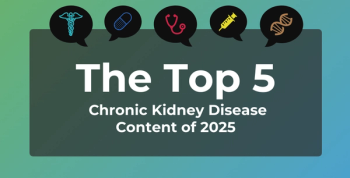
Treatment of Anemia in CKD During COVID-19
Managing treatment of anemia in CKD and gaps in care during the COVID-19 pandemic.
Transcript
Peter L. Salgo, MD: We’re clearly in the era of COVID-19 [coronavirus disease 2019]. That’s occupied all of us for a long time. It’s basically shut down our hospitals for a while. From the clinicians, is this affecting the way you’re treating things? Are you going more toward oral therapy with fewer visits to facilities where patients would have to congregate and interact with health care workers?
Robert Provenzano, MD, FACP, FASN: Dan, do you want to start?
Daniel W. Coyne, MD: Sure. What we’ve seen is first the unintended consequences from the presence of COVID-19. It led to patients for whom we were managing their anemia, say with epoetin, and we had a hemoglobin target in mind. They were supposed to get monthly hemoglobin checks. Some of them might have even been coming in for their injections, and they just stopped. That didn’t happen, so there was this gap in care. Then there were more conscious decisions of us deciding that individuals could delay institution of care. We switched their injections to home therapy if they were coming in for it. We started to open up our infusion center much earlier than we were opening up any of our clinics, so we were fortunate to be able to get people in and give them IV [intravenous] therapies, including IV iron, within a month or so of the shutdown. It was a real change, and could we go to all oral therapy? We probably could have. I mentioned Auryxia [ferric citrate] earlier. That would have been another option if we were unable to give IV iron.
Peter L. Salgo, MD: Does this change the way the payers have looked at all of this? Are you willing to pay more?
Robert Provenzano, MD, FACP, FASN: If I may, Peter.
Peter L. Salgo, MD: Go ahead.
Robert Provenzano, MD, FACP, FASN: I want to add to what Dan said because the answer is unique to individual states given the access that patients would have to health care institutions and some of the regulations. From what we saw in Michigan, first of all there’s a big shift to telehealth. Patients became frightened to come to any health care facility even if they were masked, so there isn’t 1 answer, but a lot of that is going back to normal. Telehealth is here to stay, but the fear factors have dropped off significantly.
Peter L. Salgo, MD: Yeah, I’m here in the hub of this all. I’m coming to you from Manhattan, and our numbers are dramatically down. Some of this may be transient. From a payer community, has there been a change in what you’re willing to pay for?
Stanley Crittenden, MD: It’s still too early, and the payer community is learning as we go about how to manage the right time, right place for utilization of services. It is to be determined.
Peter L. Salgo, MD: Alright. Are there gaps from a clinician’s perspective right now, without going into the newer therapies, just the therapies we’ve discussed? In terms of safety, administration, and efficacy, what are you looking for?
Robert Provenzano, MD, FACP, FASN: Dan, you want to go ahead?
Daniel W. Coyne, MD: Oh, go ahead.
Robert Provenzano, MD, FACP, FASN: I was going to say, to Stanley’s earlier comments and certainly building on Dan, we have 30 years of good understanding of managing anemia using ESA [erythropoietin stimulating agents] and iron combinations. We understand the safety well, we understand both the population health issues and the individual patient care issues, and we even understand the efficacy based on states of inflammation and other items. I am personally comfortable with my understanding of how to administer, the safety profiles, and the efficiency. Remember, we’re delivering a drug, erythropoietin and ESA, at pharmacologic doses, and data from the TREAT and CHOIR trials suggest that, as you mentioned, high pharmacologic doses might be problematic when it comes to cardiovascular outcomes. Being comfortable with what you know should not inhibit you from moving into the future of anemia management, and we’re going to talk a bit about that.
Peter L. Salgo, MD: If you wanted to make up a wish list of all those things that you would like to do, but the standard therapies, up until the present day, don’t give you in terms of safety and efficacy, what is your set of bullet points? What would that wish list include?
Robert Provenzano, MD, FACP, FASN: Dan?
Daniel W. Coyne, MD: To play off what we have is this: number 1, no infusions or injections. Patients don’t like them. The problem with epoetin is that they need to keep giving them. That product also needs to be stored in a refrigerator and not frozen, and God knows what they do once they get it home. You’re giving them an expensive therapy that they’re supposed to store properly. Those are all big issues. Ideally, therapies that are oral can be given on a simple standard treatment plan. Once a day, people can do that sort of thing—3 times a week, fine, people can do that. You don’t want to get into anything more complex than that, so avoiding all of that would be ideal.
Robert Provenzano, MD, FACP, FASN: I’ll build on that. I agree with Dan: an oral agent, as well as frequency of dosing because of pill burden, avoidance of iron, and storage requirements are absolutely critical, and a product that is potentially safer and doesn’t have the cardiovascular problems associated with ESAs is needed.
Daniel W. Coyne, MD: It may even be more stable hemoglobin levels, so you don’t have to check it every 28 days. It would be nice if, once you proved that they were stable after several months, then a check every 2 or 3 months would be adequate. That would be wonderful.
Peter L. Salgo, MD: What’s interesting to me is that I trained a long time ago, and I understood every bullet point that we’ve made in this discussion so far. What that means to me is that, up until right now, there has not been a lot of new stuff out there.
Robert Provenzano, MD, FACP, FASN: The only issue was that they were building on erythropoietin, creating longer half-lives. Whether it’s darbepoetin, which is given every couple of weeks, or Mircera [methoxy polyethylene glycol-epoetin beta], which you can dose monthly, and maybe some of the biosimilars.
Peter L. Salgo, MD: OK, but that’s it. That’s gilding the lily, it would seem to me.
Daniel W. Coyne, MD: One drug class, 25 years.
Peter L. Salgo, MD: Right.
Newsletter
Stay ahead of policy, cost, and value—subscribe to AJMC for expert insights at the intersection of clinical care and health economics.





























































